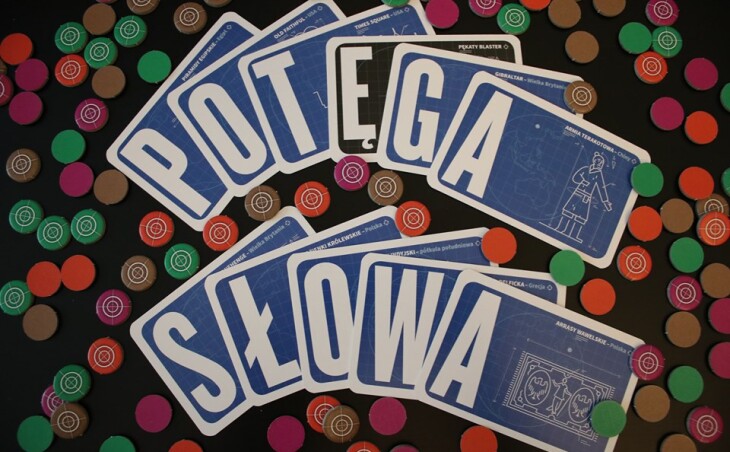The new game of our bookstore publishing house appeared on the table and surprised my fellow players. Arranging words from the available letters is known to everyone from the popular Scrabble title , so the general idea of the gameplay is not new. Does the Power of the Word still have anything revealing to offer?
In the game, we play the role of villains, whose task is to take control of as many objects as possible on the cards. Each of them has a letter and an associated drawing (eg L – Louvre, A – Alcatraz). Each player receives his markers and a character card, which is also an abbreviation of the rules, as well as a starting letter. Depending on the number of people, randomly place the cards on the table in a 4 × 4, 5 × 5 or 5 × 6 layout, prepare the round tile and designate the first player. The whole preparation takes only a moment, and the rules can be explained while unfolding.
How do we arrange the words?
From the available pool we come up with a word that must contain our starting letter. We add it in any place, so that it touches at least one side with the cards already laid out, and then we leave one marker on each letter that is included in our password. And that’s it. There are, of course, limitations – you cannot use the same card twice (to create a “kayak” you must have two “K” cards). Also, be aware of words already made up by all players so that you do not use similar words that mostly contain the same letters (eg “bicycle” and “bicycle”). After placing the tokens, we check if we managed to get any cards, and at the end of our turn we choose one from the face-down pile – this is where we will start the next move.
An object is captured when two markers of the same color are on the same letter after the markers have been placed. When we place it where another is already lying, it is “pushed” and returns to its owner. In this way, the villains fight for dominance over the individual cards. Once acquired, it becomes the player’s property and can be used to form words in subsequent rounds. The card from the pile face down is placed on the empty space on the table and the place is marked with your color. Finally, areas with three or more captured objects next to each other earn points, as do cards in our supply.
Help!
What if we can’t come up with any word from the letters available? We can use the help of other players. The helping person gets a payment for this, which is agreed with the player who is taking the turn. But what for? After all, we are the villains who fight for dominance over individual objects. Cooperation is not our strongest point. It didn’t happen in my games, but this option can be helpful when adults with children are sitting at the table, who may be worse at composing passwords.
Coming up with words in the first and second rounds is fairly easy. We have a lot of letters available and don’t feel a lot of competition. Then it starts to get hotter as we realize that we will only form 6 words throughout the game. Only this number of rounds consists of a game. In addition, many objects are occupied by other players and with the next word they can collect them for themselves. This forces you not only to carefully add your letter at the beginning of the turn, but also to make a choice – it is better to take more empty spaces so far, or to throw other people’s chips, delaying the vision of their acquisition by rivals? Or maybe stay focused on your goal and earn cards without looking at the actions of others? It is difficult to find a golden mean, and the players also face similar dilemmas. And they will certainly not give us a discounted fare.
Easy, hard, harder
Arranging words as the game progresses becomes more and more challenging, due to the scattering of cards on the table, “holes” for those already gained, and your own resources located next to the playing field. This is a pretty good mental training exercise, and coming up with a long expression feels satisfying, especially when it involves throwing other people’s chips and getting more cards. For people who want to diversify subsequent games, I recommend using black letters. They can be used like blue ones, or after placing a marker on them, perform a special action. They are described at the end of the manual and allow, among other things, to remove any tag or use the same letter twice.
From the minuses, I can mention the place the game takes on the table. You have to focus on expanding the field, which can be problematic with such a small card game. We will definitely not play it on the go, because there is simply not enough space. You also don’t feel the atmosphere for a penny, but nobody expects it from a word game. It is properly made, and the characters’ boards are very nice, colorful and functional. In addition, they introduce a bit of humor with the names of the characters (Klara Roft, Kari Mata).
Noteworthy is also a large number of objects on the cards, which apart from the name, also have a sketch and location. I value educational values, so a huge plus for a large dose of knowledge that can be learned during the game.
Nasza ocena: 7.5/10
A surprising word game with a lot of fun in only a few rules.ORIGINALITY: 7/10
REPLAYABILITY: 8/10
PRODUCTION QUALITY: 8/10
PLAYABILITY: 7/10

